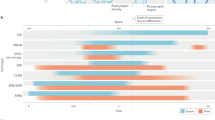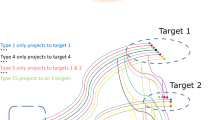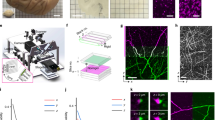Abstract
Microspheres (beads) tagged with different fluorescent markers can be used for double retrograde axonal tracing of CNS connections. They have several advantages over other double tracer techniques, including ease-of-use, high transport efficiency, distinctive cell labeling and the ability to produce well-defined injection sites. In this protocol we describe the basic procedure for their use, some common problems and how these can be overcome. The protocol, including animal surgery, preparation and delivery of tracer can be completed in approximately 0.5 d. Subsequent histological processing (excluding survival time) can be completed in 0.5–1 d.
This is a preview of subscription content, access via your institution
Access options
Subscribe to this journal
Receive 12 print issues and online access
$259.00 per year
only $21.58 per issue
Buy this article
- Purchase on Springer Link
- Instant access to full article PDF
Prices may be subject to local taxes which are calculated during checkout

Similar content being viewed by others
References
Kobbert, C., Apps, R., Bechmann, I., Lanciego, J.L., Mey, J. & Thanos, S. Current concepts in neuronatomical tracing. Prog. Neurobiol. 62, 327–351 (2000).
Ruigrok, T.J.H. & Apps, R. A light microscope-based double retrograde tracer strategy to chart neuronal connections. Nat. Protoc. 2, 1869–1878 (2007).
Katz, L.C., Burkhalter, A. & Dreyer, W.J. Fluorescent latex microspheres as a retrograde neuronal marker for in vivo and in vitro studies of visual cortex. Nature 310, 498–500 (1984).
Katz, L.C. & Iarovici, D.M. Green fluorescent latex microspheres: a new retrograde tracer. Neuroscience 34, 511–520 (1990).
Honig, M.G. & Hume, R.I. Dil and diO: versatile fluorescent dyes for neuronal labelling and pathway tracing. Trends Neurosci. 12, 333–335, 340–341 (1989).
Bentivoglio, M., Kuypers, H.G., Catsman-Berrevoets, C.E., Loewe, H. & Dann, O. Two new fluorescent retrograde neuronal tracers which are transported over long distances. Neurosci. Lett. 18, 25–30 (1980).
Schmued, L.C. & Fallon, J.H. Fluoro-Gold: a new fluorescent retrograde axonal tracer with numerous unique properties. Brain Res. 377, 147–154 (1986).
Schmued, L., Kyriakidis, K. & Heimer, L. In vivo anterograde and retrograde axonal transport of the fluorescent rhodamine-dextran-amine, Fluoro-Ruby, within the CNS. Brain Res. 526, 127–134 (1990).
King, V.M., Armstrong, D.M., Apps, R. & Trott, J.R. Numerical aspects of pontine, lateral reticular, and inferior olivary projections to two paravermal cortical zones of the cat cerebellum. J. Comp. Neurol. 390, 537–551 (1998).
Apps, R. & Garwicz, M. Precise matching of olivo-cortical divergence and cortico-nuclear convergence between somatotopically corresponding areas in the medial C1 and medial C3 zones of the paravermal cerebellum. Eur. J. Neurosci. 12, 205–214 (2000).
Schofield, B.R., Schofield, R.M., Sorensen, K.A. & Motts, S.D. On the use of retrograde tracers for identification of axon collaterals with multiple fluorescent retrograde tracers. Neuroscience 146, 773–783 (2007).
Apps, R., Trott, J.R. & Dietrichs, E. A study of branching from the inferior olive to the x and lateral c1 zones of the cat cerebellum using a combined electrophysiological and retrograde fluorescent double-labelling technique. Exp. Brain Res. 87, 141–152 (1991).
Kolston, J., Apps, R. & Trott, J.R. A combined retrograde tracer and GABA-immunocytochemical study of the projection from nucleus interpositus posterior to the posterior lobe c2 zone of the cat cerebellum. Eur. J. Neurosci. 7, 926–933 (1995).
Apps, R. Input-output connections of the “hindlimb” region of the inferior olive in cats. J. Comp. Neurol. 399, 513–529 (1998).
Apps, R. Rostrocaudal branching within the climbing fibre projection to forelimb-receiving areas of the cerebellar cortical C1 zone. J. Comp. Neurol. 419, 193–204 (2000).
Pardoe, J. & Apps, R. Structure-function relations of two somatotopically corresponding regions of the rat cerebellar cortex: olivo-cortico-nuclear connections. Cerebellum 1, 165–184 (2002).
Herrero, L., Pardoe, J. & Apps, R. Pontine and lateral reticular projections to the c1 zone in lobulus simplex and paramedian lobule of the rat cerebellar cortex. Cerebellum 1, 185–199 (2002).
Edge, A.L., Marple-Horvat, D.E. & Apps, R. Lateral cerebellum: functional localization within crus I and correspondence to cortical zones. Eur. J. Neurosci. 18, 1468–1485 (2003).
Odeh, F., Ackerley, R., Bjaalie, J.G. & Apps, R. Climbing fibre afferents govern the topography of cerebro-ponto-cerebellar projections linking the somatosensory and cerebellar cortices in rats. J. Neurosci. 25, 5680–5690 (2005).
Acknowledgements
The authors gratefully acknowledge the supreme technical expertise of Rachel Bissett, and also many thanks to Charli Flavell for providing the photomicrographs. This work was supported by grants from the Biotechnology and Biological Sciences Research Council (BBSRC) and the Wellcome Trust.
Author information
Authors and Affiliations
Corresponding author
Ethics declarations
Competing interests
The authors declare no competing financial interests.
Rights and permissions
About this article
Cite this article
Apps, R., Ruigrok, T. A fluorescence-based double retrograde tracer strategy for charting central neuronal connections. Nat Protoc 2, 1862–1868 (2007). https://doi.org/10.1038/nprot.2007.263
Published:
Issue Date:
DOI: https://doi.org/10.1038/nprot.2007.263
This article is cited by
Comments
By submitting a comment you agree to abide by our Terms and Community Guidelines. If you find something abusive or that does not comply with our terms or guidelines please flag it as inappropriate.



